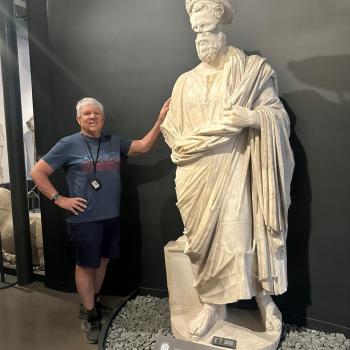Ann and I had the pleasure of having dinner one night in Milan at the SNTS meeting at the bishop’s palace not quite 20 years ago. We were the guests of Cardinal Martini, as was the rest of the several hundred members of the SNTS. We were served in the spacious courtyard of the bishop’s palace by waiters wearing tuxedos, and the hospitality could hardly have been more grand. It was one of the more memorable evenings ever at the SNTS meetings that I have attended. Below you will find Larry Hurtado’s personal tribute to Cardinal Martini, who in addition to being a very fine churchman was also an excellent NT textual scholar. He combined eruditio et religio well indeed, and will be missed.
Carlo Maria Martini: RIP
by larryhurtado
I learned only yesterday that Cardinal Carlo Maria Martini had died, and (the reason it was picked up by UK news outlets) had given a dead-bed interview in which he had expressed strong views on how the Roman Catholic Church (and European churches more generally) needed to be renewed and reformed. I know of Martini in another capacity, however, as a NT scholar and particularly for his contributions to NT textual criticism. I was asked in an email whether in fact he was a real and respected biblical scholar. Unquestionably, yes. His willingness to take on senior roles in the Catholic Church made it difficult thereafter to continue doing the original research that characterized his earlier years as a NT scholar. But he is noted for some important work.
In particular, I point to his study of Codex Vaticanus in the light of the then recently-published Bodmer Papyrus XIV (aka P75), the remains of a manuscript of Luke and John dated palaeographically ca. 200 CE: Carlo M. Martini, Il problema della recensionalita del codice B alla luce del papiro Bodmer XIV, Analecta Biblica, no. 26 (Rome: Pontificio Istituto Biblico, 1966).
Prior to his study, it had often been asserted that the sort of text we have in Codex Vaticanus was the product of an early 4th century redaction supposedly done under ecclesiastical authorities. But the discovery and publication of the Bodmer Papyrus XIV in 1961 brought important new evidence to light, and Martini was among the first to produce to draw out the significance of this manuscript.
“p75” (as it is referred to commonly by NT scholars) exhibits a text of Luke and John that makes it the closest “relative” of Codex Vaticanus, these two manuscripts agreeing in excess of 90% of all variation-units in Luke and John. So, this means that the kind of text for which Codex Vaticanus (Codex B in NT parlance) is famous (the “neutral” text of Westcott and Hort) was not the product of a 4th or even 3rd century recension, but was already circulating by ca. 200 CE. This put the text at the head of the pack, so to speak, P75 among the earliest witnesses to the text of the NT.
Partly because he published his study in Italian, it hasn’t been cited as often as some other studies that came along shortly thereafter. For an accessible explanation of the significance of P75, Gordon Fee’s essay is commendable:
Gordon D. Fee, “P75, P66, and Origen: The Myth of Early Textual Recension in Alexandria,” in New Dimensions in New Testament Study, ed. Richard N. Longenecker and Merrill C. Tenney (Grand Rapids: Zondervan, 1974), reprinted in E. J. Epp and G. D. Fee, Studies in the Theory and Method of New Testament Textual Criticism (Grand Rapids: Eerdmans, 1993), 247-73.
Martini held the professorial chair in NT Textual Criticism in the Pontifical Biblical Institute, and also served on the editorial board that prepared the 26th edition of the Novum Testamentum Graece (the standard hand-edition of the Greek NT) and the United Bible Societies’ Greek New Testament. He was the only Catholic scholar to be invited to serve in that role.
I cannot speak to his churchmanship or his role as Bishop (of Milan) and then Cardinal. Not a Catholic myself, I can’t speak to his comments about his Church. But it is fitting to remember with gratitude and appreciation his contributions to NT textual criticism.













